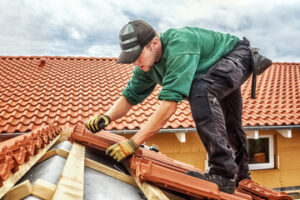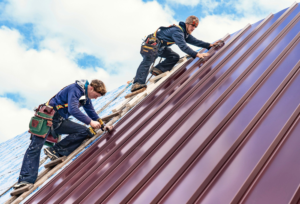While an occasional leak may not be an emergency, any damage that threatens the integrity of your roof and home should be immediately addressed. Major leaks can destroy drywall, carpets, furniture and other items. For professional assistance, contact Emergency Roofing Columbus GA.

Start by visually inspecting the damage and documenting its scope. This will help when working with roofing professionals on insurance claims later.
A leaking roof is one of the most pressing reasons to call for emergency roofing. A leak can cause significant water damage and mold in your home, so it should be repaired as soon as possible to avoid more expensive repairs down the road. The first step is to identify the leak source. Look for puddles, wet spots, dark streaks and discoloration on the ceiling. You can also check the attic for wet rafters and damp insulation.
Water leaks can occur for many reasons, including storm damage, aging roof materials and animal intrusion. While a leak can appear in any part of your roof, it is more likely to happen around skylights, chimneys and roof valleys.
When a leak becomes an emergency, you may need to move your belongings away from the affected area to prevent further damage. Placing a tarp over the leak is a good temporary solution until you can have it fixed.
If you have a severe leak and are concerned about the structural integrity of your roof, it’s best to move out until the situation can be inspected and fixed by professionals. However, if you have a small leak in the living room, it’s a less urgent issue and can probably wait until normal business hours.
If you do decide to stay, you can minimize the damage by placing buckets or other receptacles underneath the leaking area. It’s important to move your valuables and electronics out of the way to protect them from water damage. If you can’t move your belongings, it’s a good idea to place plastic sheets or tarps over them to protect them from the rain until the leak is repaired. A trusted local contractor will be able to provide a permanent leak repair after an inspection of the damaged area. They will also be able to work with your insurance company to get the claim process started. Choosing a local contractor with good connections with established roofing manufacturers will help you get high-quality roofing materials at lower rates. The contractors will also have the experience to work with all kinds of roofing systems and weather conditions to provide durable, long-lasting solutions.
Wind Damage
When a roof becomes damaged due to severe weather, it can create a variety of emergencies. From water leaks to structural damage, these issues need to be addressed immediately in order to protect your home’s interior. However, it can be difficult to know when your roof has reached the point of needing emergency repairs. The best way to identify such problems is through regular roof inspections. However, if you notice large areas of your home with obvious signs of water damage (like water stains on the ceiling), then you should consider it to be an emergency and contact your roofing contractor immediately.
Similarly, if your roof has sustained significant wind damage, it may need emergency repair services. This type of damage can range from missing shingles to sections of your roof being torn off completely. A reputable roofing contractor will assess the extent of the damage and provide you with a detailed estimate of what needs to be done to restore your roof.
A good roofing company will also offer emergency services like shrink wrap sealing to avert further damage from continuing rainstorms and to protect your property until permanent repairs are made. When hiring an emergency roofing service, be sure to find one that is experienced with working through storm damage scenarios and has experience with insurance claim assistance as well.
Emergency roofing is a vital service that provides protection for your home from unexpected events. A high-quality roof that is regularly inspected and maintained can reduce the need for such service, but it’s always wise to have some financial preparation set aside in case of an emergency situation. Emergency roofing can be a costly service, but it’s important to understand how much the repairs will cost in advance so that you can make an informed decision about whether or not to go through with them. The more extensive the damage, the higher the cost will be. However, investing in a better-quality roof and materials that are designed for increased wind resistance can help to lower the cost of emergency repairs over time.
Broken Shingles
A roof’s protective layer, shingles, are an important component in preventing water leaks. When large areas of shingles are missing or severely damaged, the underlying underlayment and decking are left exposed. This is a roofing emergency that should be addressed as soon as possible to protect your home from moisture and other hazards.
Missing shingles can be caused by storm damage, wind uplift, or blunt force impact (tree branches, teenagers’ shoes). These aren’t the same as severe storm damage that may cause other issues like a collapsed section of your roof or significant sagging.
When assessing whether or not your roofing needs are an emergency, it’s important to do a thorough visual inspection of the entire affected area. This will help you identify the issue and determine the most appropriate course of action. During this inspection, take pictures or make notes to document the damage and its scope. This will be an invaluable tool when filing insurance claims or coordinating with a professional roofer for repairs.
While it may be tempting to climb onto a compromised roof to assess the damage, this can be extremely dangerous. Inclement weather can lead to slippery surfaces, hidden structural damage, and live electrical wires. Climbing onto a compromised roof in an emergency situation can be a major safety hazard for you and your family. If you notice severe damage, contact a professional to take care of the emergency.
Stains on your ceiling or walls are a clear indication that there’s a serious problem with your roof. These stains can indicate leaks, mold growth, and other issues that can be quite expensive to repair.
If you find stains on your ceiling, the first thing to do is cover the area with a tarp. This will prevent any further water damage and buy you time until a professional arrives to address the issue. If you have a shingle roof, you can also use spare shingles or metal flashing to temporarily patch up any gaps or holes. Just make sure to caulk the edges of the tarp to prevent water from seeping under it.
Tree Damage
When a tree falls on your home, the first priority is to ensure that everyone is safe. Once this is done, it’s important to assess the extent of the damage and develop a plan for emergency roofing. This will involve examining the roof to identify any breaches in the structure and determine whether there are other areas that need repair. It may also include using a tarp to temporarily protect the area until permanent repairs can be made.
If you’ve noticed that shingles are missing from your roof, this is another indication that it’s time for emergency roofing. In many cases, this is the result of high winds that blow shingles away from the attic or other sections of the roof. However, it can be caused by other factors as well. For example, squirrels and raccoons often use trees as their abode. As they move from the trees to your home, they can rip off shingles in their attempt to enter the attic or crawl space.
Another sign that your roof needs emergency repairs is if you notice that there are holes in the ceiling or walls. This can be caused by water or wind, and it’s crucial to act quickly. A hole in the wall of a living room is one thing, but a leak in the attic or near the fuse box is an entirely different matter.
Lastly, you should consider a roof emergency when you see signs of fire damage on your roof. Fire can scorch even the most durable roofing materials, causing them to disintegrate and expose your home’s interior to the elements. This can be a dangerous and costly situation, so you should contact a professional as soon as possible to start the process of emergency roofing.
While it’s impossible to stop all potential issues with your roofing, regular roof inspections are a great preventative measure. A good contractor can help you identify issues, such as displaced or damaged shingles, and get them repaired before they become serious problems. Additionally, hiring a tree expert to trim or otherwise maintain the trees near your home can minimize the risk of a fallen limb damaging your roof.

